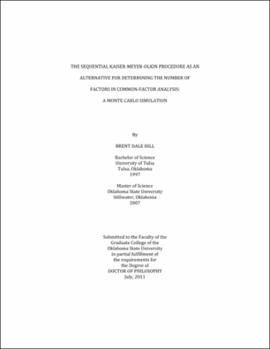| dc.contributor.advisor | Fuqua, Dale R. | |
| dc.contributor.author | Hill, Brent Dale | |
| dc.date.accessioned | 2013-11-26T08:34:32Z | |
| dc.date.available | 2013-11-26T08:34:32Z | |
| dc.date.issued | 2011-07 | |
| dc.identifier.uri | https://hdl.handle.net/11244/7431 | |
| dc.description.abstract | Scope and Method of Study: | |
| dc.description.abstract | Widely utilized in the behavioral and social sciences, common-factor analysis (CFA) is a statistical technique which is used to investigate the latent traits (factors) that underlie a set of observed variables. The proper number of factors to extract is a fundamental question in exploratory CFA, and many methods to answer that question have been devised. This study examines the performance characteristics (accuracy, precision, and bias) of four variants of the sequential Kaiser-Meyer-Olkin (SKMO), a new method for determining dimensionality in CFA. This study also compares the SKMO to various other well-known dimensionality tests, such as the Kaiser-Guttman criterion, Horn's parallel analysis, and Velicer's MAP test. This study was conducted using an extensive Monte Carlo simulation which manipulated the actual number of factors, the variable-to-factor ratio, the pattern-magnitude interval, sample size, and inter-factor correlations. | |
| dc.description.abstract | Findings and Conclusions: | |
| dc.description.abstract | The simulation revealed that the best-performing SKMO variant was that which incorporated noniterated communality estimation and a .50 cutoff. The simulation also showed that the SKMO performed better than most other number of factors tests, including the Kaiser-Guttman criterion and Velicer's MAP test. The SKMO was better than one version of parallel analysis and a close second to the remaining forms. These results suggest that the SKMO is a viable candidate for general use with CFA. However, this suggestion is tentative as further research is needed to determine the performance characteristics of the SKMO under increasingly complex conditions. is a viable candidate for general use with CFA. However, this suggestion is tentative as further research is needed to determine the performance characteristics of the SKMO under increasingly complex conditions. | |
| dc.format | application/pdf | |
| dc.language | en_US | |
| dc.rights | Copyright is held by the author who has granted the Oklahoma State University Library the non-exclusive right to share this material in its institutional repository. Contact Digital Library Services at lib-dls@okstate.edu or 405-744-9161 for the permission policy on the use, reproduction or distribution of this material. | |
| dc.title | Sequential Kaiser-Meyer-Olkin procedure as an alternative for determining the number of factors in common-factor analysis: a Monte Carlo simulation | |
| dc.contributor.committeeMember | Perry, Katye | |
| dc.contributor.committeeMember | Miller, Janice | |
| dc.contributor.committeeMember | Davis, C. Robert | |
| osu.filename | Hill_okstate_0664D_11649 | |
| osu.accesstype | Open Access | |
| dc.type.genre | Dissertation | |
| dc.type.material | Text | |
| dc.subject.keywords | common factor analysis | |
| dc.subject.keywords | dimensionality | |
| dc.subject.keywords | kmo | |
| dc.subject.keywords | map test | |
| dc.subject.keywords | monte carlo | |
| dc.subject.keywords | number of factors | |
| thesis.degree.discipline | Teaching and Curriculum Leadership | |
| thesis.degree.grantor | Oklahoma State University | |
